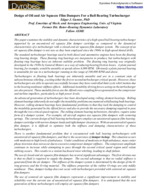Papers
“Design of Oil and Air Squeeze Film Dampers For a Ball Bearing Turbocharger,” |
Abstract
This paper examines the stability and dynamic characteristics of a high speed ball bearing turbocharger supported by an uncentered oil squeeze film damper cartridge as compared to the dynamical characteristics of a turbocharger with a closed-end air squeeze film damper system. The concept of an air squeeze film damper is not new as they been employed since the 1960s in high-speed dental drills.
The standard turbocharger bearings used in both diesel and automotive engines have been the floating ring bearing design. These floating ring bearings are inexpensive to produce, but turbochargers with floating ring bearings have an inherent stability problem. The floating ring bearing was originally developed in the 1930s by General Motors as a way of reducing bearing friction losses. A plain journal bearing, for example, would be unstable at speeds above 8,000 RPM. Obviously a plain journal bearing is unsuitable for use in a turbocharger running in the range of 100,000 RPM and above.
Turbochargers in floating bush bearings are inherently unstable and are in a constant state of subsynchronous whirling , exciting either the first or second turbocharger critical speeds. However, these turbochargers are able to operate successfully because they have controlled limit cycle whirl motion due to the bearing nonlinear stiffness effects. Additional instability driving forces acting on the turbocharger are also present. These unstable forces are the Alford cross-coupling forces generated on the compressor and turbine impellers, particularly at high power levels.
An advanced generation of turbochargers has been developed using rolling element bearings. Rolling element bearings inherently do not suffer the instability problems encountered with floating bush bearings. However, rolling element bearings have fundamental problems in that they lack the damping to control the instability generated by the Alford forces and also to provide the necessary damping required to pass through the two critical speed regions. The rolling element bearing turborotors, therefore, require some form of a damper system. For example, all aircraft engines use squeeze film dampers with centering springs. The current design of ball bearing turbochargers employs an uncentered squeeze film bearing- damper cartridge with narrow damper lands and tight damper clearances. With an uncentered oil squeeze film damper, it is difficult to optimize both the stiffness and damping characteristics of these turbochargers.
There is another fundamental problem that is encountered with ball bearing turbochargers with uncentered oil squeeze film dampers, and that is the occurrence of damper lockup. This situation occurs with moderate to high levels of unbalance. Under conditions of moderate or high unbalance, mass center phase inversion does not occur due to excessive compressor damper stiffness . The compressor amplitude continues to increase while attempting to pass through the second critical speed region until volute rubbing occurs. This results in a violent backward rotor whirling, leading to shaft failure.
The use of closed-end air squeeze film dampers has several significant advantages. The first obvious one is that no fluid is required to supply the damper. The second advantage is that no radial stiffness is generated from the air damper. The stiffness of the damper system is determined by the design of the O- ring grooves and the O-ring material. The stiffness properties of the rubber O-rings are only mildly nonlinear. Thus, damper lockup does not occur with turbochargers provided with centered air squeeze film dampers.
The use of centered air squeeze film dampers represents a significant improvement in stability and reliability over the current use of uncentered oil squeeze film dampers. It is anticipated that the next generation of these turbochargers will employ air squeeze film dampers.

